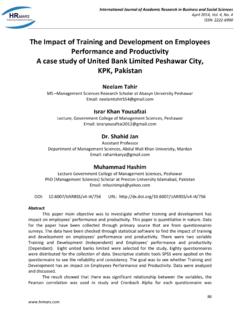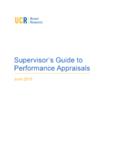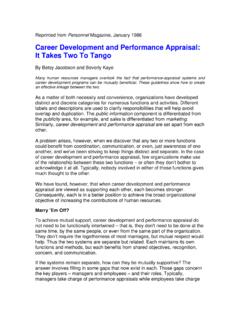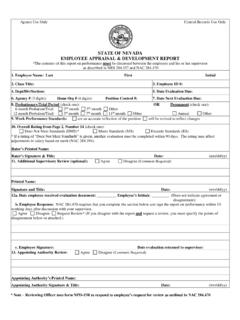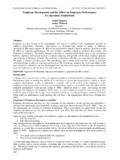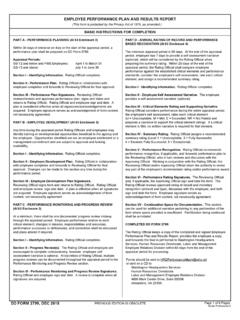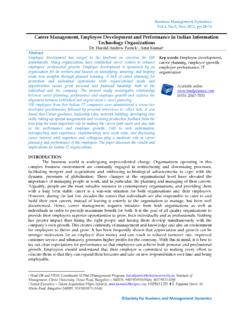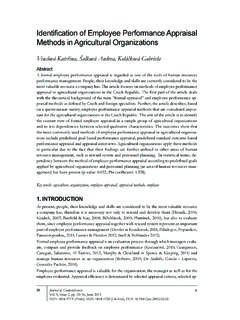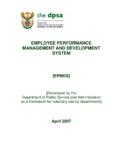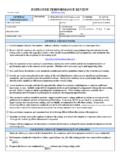Transcription of Performance Appraisal: Enhancing Employee Development ...
1 ,PattiCumbest,andMichaelJenkinsTheperfor manceappraisalprocessis anintegralpartof most,if notall,manager' employeeperformanceevaluationis to enhancetheutilizationof (ligen,Fisher,&Taylor,1979),A studybyLockerandTeel(1977)indicatesthato ver90%oforganizationsreportusingsometype of morerecentstudysuggeststhatformalapprais alsystemsarebecomingincreasinglypopular( CampbellandBarron,1982).Unfortunately,th oughmoreandmoreorganizationsareadoptingf ormalappraisalprocesses,themajorityof thereasonthatavailableperformanceinforma tionis oftennotfedbackto theemployee(Cascio,1987).Moreover,theann ualperformancereviewis oneof themostdreadedtasksbylinemanagersandis oftentreatedasa necessaryevil(BernardinandBeatty,1984).T hedilemmaof managersfeelingthenecessityof preparation,andfewerstillhaveanytraining in ,manymanagers,aswellasemployees, anantagonisticrelationshipbetweenmanagem entandstaff,whichis farfromthedesiredeffectof ,in part,fromtryingtoachievetwofundamentally conflictingfunctionsin a aneffortto combinethesetwofunctions,mostcompaniesan dindividualmanagersstressadministratived ecisionsandneglectemployeedevelopment(Bu shardt,Fowler,andDehnath,1985).
2 Performanceappraisalis usedto makejudgementdecisionsregardingpromotion ,meritraises,transfers, thesedecisionsoftenplacesmanagersandempl oyeesin ,feedbackmaybedelayedbecauseof theunpleasantnatureof relayingnegativefeedbackto theemployee( ;1979). attemptingto convincetheevaluatorthathisevaluationis incorrectin orderto receivea highermeritraiseor a short,employeesareverylikelytoassumea ,ontheotherhand,is likelytobedefensiveashisor herjudgementis legalentanglementfurthercastsa employeedevelopmentis oftenthwartedasfeedbackto enhanceperformanceis ,duringcasual,dailyinteractions, theemployee' ,especiallywhentheysuspecttheyareperform ingpoorly,oftenengagein (1989)arguesthatthesestrategiestendto minimizetheamountof 'smotivationtomaintaina positiveself-esteemcombinedwiththesuperv isor'sreluctanceto givenegativefeedbackarelikelyto contributeto thispaperis to developguidelinesforenhancingtheemployee developmentfunctionwithintheappraisalpro cess,thusseparatingit theperformanceappraisalinterview,a situationis createdin whichthemanagerandtheemployeesharea givingandreceivingfeedbackin a supportivenonthreateningatmosphereis criticalin determiningthesuccessof unconsciously, allowsoneto comparehisownperceptionsof hisbehaviorwithothers' makeappropriateadjustmentsin theirbehavior(BushardtandFowler,1987;198 9).
3 Cedarblom(1982)liststhreefactorsnecessar ytoproduceeffectiveinterviews:superior's knowledgeof subordinate'sjobandperformance,superior' ssupportof thesubordinate,andwelcomingthesubordinat e' ,eachparticipantin thefeedbackprocessshouldbothbeanactiveli stener, ,thepersonreceivingfeedbackshouldlistent owhatis saidwithoutargumentor ,feedbackcanbeeithernegativeor , whetherto givepositiveor negativefeedbackfirstis ,Gueutal,andMcintosh(1984)foundthatself- esteemmoderatestherelationshipbetweenfee dbacksequenceandperceptionof moreeffectivewhentherateris perceivedto havea highlevelof expertise,andtherecipienthasaninternallo cusof negativeandpositivefeedbackunderothersit uations,mostwritersandpractitionersrecom mendthe"sandwichapproach"wherenegativefe edbackis (1978)suggeststhatthisapproachis morelikelyto leadto acceptanceof providingeffectivefeedbackis a delicateonethatis moreof anartthana mind,thefollowingguidelinesaresuggesteda saframeworkto enhancetheperformanceappraisalprocessfor boththesupervisorandtheemployee(Bushardt andFowler,1989).
4 Besurethatyourintentionis notthetimeto showtheemployeewhois coveredin theinterviewshouldbeanefforttobuildtheem ployeebyencouragingappropriatebehaviorsa ndmodifyingbehaviorthatis betterunderstandingof whatis expected,a senseof therecipienthasnotaskedforfeedback,check to seewhetherheor sheis opento thepurposesoutlinedwhenintroducingtheemp loyeeto ,feedbackshouldnotbeprovidedin areaswheretheemployeeis notopento thefeedbackbecauselittlebehavioralchange is likelyto ,whenthemanagerprovidesfeedbackin areaswheretheemployeeis notreceptiveor open,otherfeedbackis orderto enhanceperformanceoccurinareaswheretheem ployeeis notopento usedfordevelopment,themanagershouldconce ntrateononlythosebehaviorswhichtheemploy eeis likelytobeopento ,theperformanceappraisalfordevelopmentpu rposesis likelytobecomelessthreateningandtheemplo yeeis likelytobeopento feedbackin addition,whenthetwofunctionsareseparated theemployeeis likelytoviewthedevelopmentfunctionasa teamapproachandusetheopportunitytoreceiv efeedbackthatwillenhancehisor herappraisalat"judgementtime," is fairlyobviousthatit is uselesstoprovidenegativefeedbackonanempl oyee'sbehaviorif heor shecannotchangeor ,everypositionin ,therealityof organizationallifeis thatemployeesbringlimitationswiththemtha tofteninhibitperformanceandpreventthemfr ombeingthatidealemployeeaboutwhich' theselimitationsareunacceptabletheemploy eeneedsto betransferredintoa differentpositionor encouragedto tobeableto identifywhatis a changeablebehaviorandwhatis nota changeablebehaviorfora.
5 Obesityisgenerallyregardedasa changeablebehaviorin oursociety, thatforsomeindividualsthisis nota changeablebehavior,at theseindividualsconcerninghisweightis ,thekeyissueis theabilityto discernthedifferencebetweena changeablebehavioranda behaviorthatis closerelationwiththeemployeeandanunderst andingof , additiontolimitingfeedbackto changeablebehavior,youshouldalsoexercise cautionbyavoidinggeneralities( ,"you'realwayslate","you'rejusta happyperson").Thispointmaybeespeciallyim portantwhengivingnegativefeedbackbecause it is simpleruleto followin orderto avoidgeneralitiesis to"neversayalwaysor never."A favoritewordin ourcultureis a generalityandcommunicatesverylittleto providingfeedbackthemanagershouldattempt to usebehaviorasopposedto objectivein thesensethatit canbemeasured,counted, ,ontheotherhand,area cognitiveprocesswhichis unlikelytograspthemessagewhentold,"hehas anattitudeproblem"(BushardtandSchnake,19 81).
6 Themanagershouldusethe"managementbywalki ngaround"approachto experiencetheemployees'behaviorfirsthand andobtainspecificbehavioralexamples(Pete rsandAustin,1985).Describethebehavior; orderto ensurethatemployeegrowthanddevelopmentwi llresultfromtheappraisalinterview, ,providingspecificbehavioralexampleswhen possible(BushardtandSchnake,1981).Forexa mple,whenthemanagertellstheemployeethath eis irresponsiblefornothavingthereportin ontime,themanageris thediscussionis likelyto centerontheemployee'scharacterandthereal issueof beinglatewiththereportis ,a discussionof theemployee' moreappropriatewayforthemanagerto handletheissueis to say,"yourreportshavebeenlatethelasttwoFr idaysandI feelangryaboutthis."letthepersonknowthei mpactof ,"youmakemeangrywhenyouarelatetowork,"th emanagerisinappropriatelytryingto maketheotherpersonresponsibleforthemanag er' "/ statements"( "/ feelangrywhenyouarelatetowork")
7 Anuntruestatementbecausetheemployeedoesn otcontrolthemanager'semotionsandcannotma kethemanager,or anyoneelse, a personalone,beyondthecontrolof "I"toacceptresponsibilityforone'sownfeel ingsis anhoneststatementwhichis likelyto beacceptedbytheemployee,asopposedtoblami nghimforone' ,checkto specificbehaviorit is notuncommonforthemto heara ,whenthemanagersaysto theemployee,"youhavenotdemonstrateda willingnessto takeinitiativewithnewassignmentsaseviden cedbyyourrefusalto acceptthenewtasksI passedtoyoulastweek,"theemployeeis likelytohearthatthemanagerperceiveshimor herasincompetentandnota ,themanagershouldcheckto seeif theemployeeunderstoodthemessageasit wasintended:a rejectionof thebehaviorandnota rejectionof theindividualor a threatto alsoa goodtimeto asktheemployeeforassistancein developinga planforareasin needof is importantfortheemployeetounderstandthatt hefocusof theappraisalis Development ,andthatthemanagerandemployee areworkingasa teamto helptheemployeetobecomethebestheor shecan,or desiresto, theappraisalis theinterviewshouldbehighwhenthecontentof theinterviewis nonthreateningto thesubordinate,thesubordinateisknowledge ableandpersonallyindependent,or if thesubordinateis a longertermemployeewhois accustomedtoparticipationwiththesupervis or( ).
8 Thewaythemanageracceptsfeedbackplaysa keyrolein ,if notmost,employeesentertheevaluationproce sswithexpectationsofconfrontationanda limitedsetof skillsrelatingto ,asarolemodel,is a keyelementin reshapingthebehavioralexpectationsof theemployee(Bandura,1969).Thefollowinggu idelinesmaybehelpfulin specificaspectof yourbehavioryouwillmakeit easierforothersto specificbehavioralareas,othersaremorelik elytobelievethatyouaresincerelyattemptin gto theemployeein whichareasyouareopentofeedback, allareasof themanagerrespondsto feedbackwithdefensiveverbalor non-verbalbehavior,theemployeeis ,theemployeeis morelikelytorelyondefensivebehaviorwhenh eor sheis ,theydonothavethechancetohear,muchlessev aluate,thefeedbackheor receivingfeedbackisthereceiveralwayshast heoptionof incorporatingthefeedbackwithinhisor herbehavioralrepertoireor orderto is notuncommontorestatethefeedbackverbatimo r slightlyparaphrasedandhavetheemployeedec larethatis factbewhathesaidevidentlyit is.
9 Clarificationis veryimportantandthepersonreceivingthefee dbackshouldrelyheavilyonactivelistenings killstoattempttounderstandwhatthepersonm eansasopposedto whatheis theprocess,butit is centralto is importantthatyouexpressappreciationforth einformationprovided,whetherit providedinsightor , whicha managerrespondstoreceivingfeedbackwillha vea majorimpactonthewayin whichtheemployeereceives feedbackin modelingbehavioris welldocumentedin theliterature(Bandura,1969).FrequencyofP erformanceEvaluationPerformanceappraisal interviewsareoftenanannualeventwhichmayb eeffectiveasfarasjudgementdecisionsareco ncernedbuttendtobeinadequatewhereemploye edevelopmentis (1982) nonroutinejobsshouldbeinterviewedat flexibleintervals(generallymorethanoncea year) routinejobsshouldbeinterviewedin orderto ,neweror theevaluationprocessis effectivein (specifically,analyzingjobresponsibiliti esandduties,problemsbeingencounteredonth ejobandqualityof jobperformance)is associatedwithmorepositiveinterviewoutco mesandsignificantlyrelatedto jobperformanceimprovements(Burke,Weitzel ,& Weir,1978).
10 SilvermanandWexley(1984)foundthatpartici pationin constructionof behaviorallyanchoredratingscales(BARS)us edin performanceevaluationledto favorableperceptions,aswellaspositiveout comes, hasbeenpointedoutthatoneadvantageof BARS mayhavenothingto dowithmeasurementof performancebutstemsfroma highdegreeof involvementof workersandsupervisorsin scaledevelopment(Landy& Trumbo,1980).In short,employeeparticipationin thedevelopmentof theinterviewprocessthemanagershouldlimit negativefeedbackto theemployeetoonlytwoor ,a listbeyondtwoor threeoftenbecomesoverwhelmingwiththeresu ltbeingthattheemployeetunesthemanagerout orbeginsto thatlittleor morethantwoor threenegativebehaviorsneedaddressingit is moreeffectivetodealwitha tendencyexistsamongmanymanagersto stressonlywhattheemployeeisdoingwrongand torequestbehavioralchangein theappraisalprocessthemanagershouldalsor einforcepositiveperformancebehaviorsthat theemployeeis 'sbehavior,themanagershouldtaketimeto stressthatheor shevaluestheemployeeasa is importantto differentiatebetweentheemployee'sbehavio randtheirvalueasa addition,whennegativefeedbackis provided.
